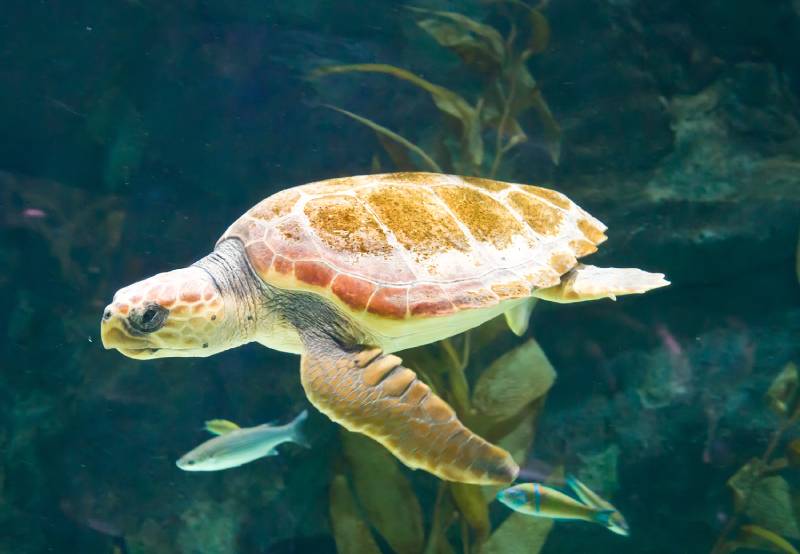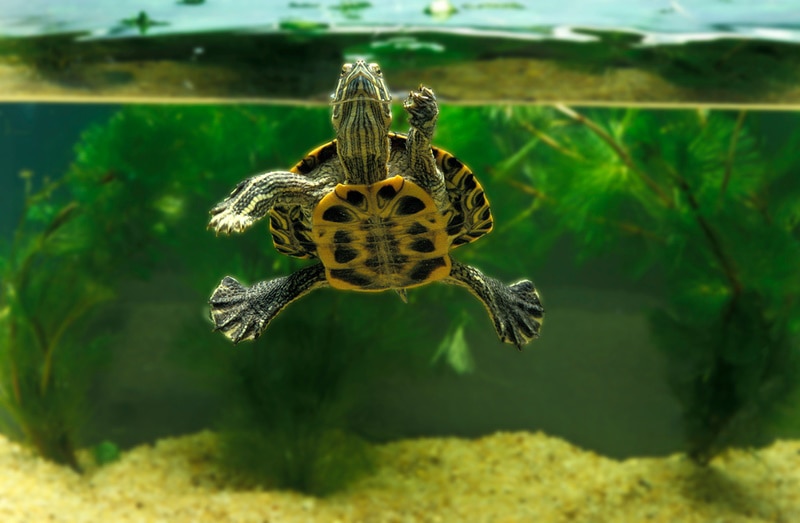How Fast Can a Turtle Swim? Interesting Facts & FAQ
Updated on

Turtles are truly incredible creatures that have always symbolized wisdom, patience, and the art of slow living. Most fables and children’s tales depict turtles as slow creatures, taking forever to find their way on land. However, turtles spend most of their lives in water, so how fast can turtles really swim?
You will be surprised to learn that a Leatherback Sea Turtle can swim up to 22 miles per hour (around 35 km/hr). This sea turtle is incredibly fast and can even dive to great depths. Most sea turtles rely on their swimming abilities to survive, so keep reading to find out how they manage to swim so fast with their bulky bodies.
Types of Aquatic Turtles
We can make a simple division of sea turtles and semi-aquatic (also known as terrapins) species when talking about turtles. Semi-aquatic turtles either spend their days in and out of the water, whereas sea turtles spend their entire time in water, emerging onto land only to lay eggs.
- Green Turtle
- Hawksbill
- Kemp’s Ridley
- Loggerhead
- Olive Ridley
- Leatherback
- Flatback
While all of these turtles are unique and interesting, we will dwell on the topic of the fastest swimmer in the group, a title that belongs to the Leatherback turtle.

The Fastest Swimming Turtle
The fastest and also largest turtle on earth is the Leatherback Turtle. Its name comes from its unique appearance—it lacks a traditional turtle shell. Instead, its back is covered by firm, rubbery skin, which looks more like leather than a shell. This turtle is widespread across the Atlantic and Pacific oceans, although its numbers are in decline because of the human impact in the last century. Their status globally is “Vulnerable,” while some subpopulations are “Critically Endangered” 1.
The adult Leatherback turtle can weigh as much as 2,000 pounds, making it the largest turtle species. It is an excellent swimmer and diver, diving up to 4,000 feet underwater 2. They are also known to be the fastest swimming turtles, reaching an impressive 22 miles per hour (around 35 km/hr).
How Fast Can Turtles Swim Compared To Other Animals
To better understand how fast the Leatherback can swim, we compared their skills with other animals. While a human’s record in swimming reaches 6 miles per hour (9.7 km per hour), the fastest swimmer in the world is the Sailfish reaching speeds of approximately 70 miles per hour (113 km/hr).
If you’ve ever seen dolphins swimming in sync with a boat, you probably witnessed them swimming nearby. Dolphins can reach similar swimming speeds as sea turtles, so imagine how fast the Leatherback Turtle can swim!

How Long Can Turtles Remain Underwater?
Aquatic turtles spend most of their lives in the water. However, some of them must return to land to lay eggs. They show extraordinary abilities during their time in the water, such as staying underwater for long periods. When active, turtles must reach above for air every few minutes. However, when they are in a state of rest, they can remain underwater without breathing for as long as 2 hours. Sea turtles can remain without surfacing for up to 7 hours when resting.
How Are Turtles Such Great Swimmers?
Because swimming is a regular part of a turtle’s everyday life, they must be as skilled swimmers as possible to avoid predators and catch prey. To achieve such impressive speeds, they use all four of their legs. Most freshwater turtles have webbed feet, an important asset for paddling and fast swimming.
On the other hand, sea turtles have long flippers instead of webbed feet to propel them through the water. Their back flippers also have the amazing purpose of helping them steer. Female sea turtles use their back legs to dig up places to nest in the sand and lay their eggs.
Conclusion
Turtles are fascinating creatures that always impress us with their extraordinary bodies and abilities. Whether semi-aquatic or aquatic, they possess incredible swimming capabilities that allow them to spend their lives safely in the water. After learning how fast a turtle can actually swim, you probably realized you should never underestimate these incredible creatures.
While they may seem slow and unprotected on the land, they can find their way quicker in the water than most other animals.
Featured Image Credit: Nerify, Shutterstock












